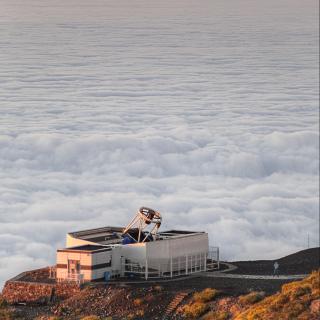It may interest you
-
 IAC researcher David Aguado has obtained a prestigious Starting Grant from the European Research Council (ERC), aimed at promoting promising young scientists. This is the third ERC grant -one of the most competitive and recognized of the Horizon Europe program- that the center has received so far this year, thus consolidating its international projection. These highly competitive grants provide up to €1.5 million over five years to support outstanding young scientists in establishing their own independent research groups and pursuing pioneering scientific ideas. Searching for the first starsAdvertised on
IAC researcher David Aguado has obtained a prestigious Starting Grant from the European Research Council (ERC), aimed at promoting promising young scientists. This is the third ERC grant -one of the most competitive and recognized of the Horizon Europe program- that the center has received so far this year, thus consolidating its international projection. These highly competitive grants provide up to €1.5 million over five years to support outstanding young scientists in establishing their own independent research groups and pursuing pioneering scientific ideas. Searching for the first starsAdvertised on -
 El Instituto de Astrofísica de Canarias (IAC) ha sido distinguido por la Delegación del Gobierno en Canarias con uno de los reconocimientos entregados durante el acto de conmemoración del 47 aniversario de la Constitución española de 1978, celebrado este 6 de diciembre y presidido por el delegado del Gobierno en Canarias, Anselmo Pestana. La Delegación del Gobierno ha reconocido la labor del IAC, que celebra su 40 aniversario, en virtud del artículo 44.2 de la Constitución Española, por su fundamental contribución a la promoción de la ciencia y la investigación científica y técnica enAdvertised on
El Instituto de Astrofísica de Canarias (IAC) ha sido distinguido por la Delegación del Gobierno en Canarias con uno de los reconocimientos entregados durante el acto de conmemoración del 47 aniversario de la Constitución española de 1978, celebrado este 6 de diciembre y presidido por el delegado del Gobierno en Canarias, Anselmo Pestana. La Delegación del Gobierno ha reconocido la labor del IAC, que celebra su 40 aniversario, en virtud del artículo 44.2 de la Constitución Española, por su fundamental contribución a la promoción de la ciencia y la investigación científica y técnica enAdvertised on -
 The IAC's Educational Project with Robotic Telescopes (PETeR) offers a new edition of its online teacher training entitled ‘ Investigate the Universe with Robotic Telescopes’. This activity, organised in collaboration with the STEAM area of the regional Ministry of Education of the Canary Islands Government, aims to provide knowledge and tools to incorporate astronomy in the classroom through the use of professional robotic telescopes, the analysis of scientific data and active learning methodologies. PETeR is an educational project that gives schools free access to professional telescopesAdvertised on
The IAC's Educational Project with Robotic Telescopes (PETeR) offers a new edition of its online teacher training entitled ‘ Investigate the Universe with Robotic Telescopes’. This activity, organised in collaboration with the STEAM area of the regional Ministry of Education of the Canary Islands Government, aims to provide knowledge and tools to incorporate astronomy in the classroom through the use of professional robotic telescopes, the analysis of scientific data and active learning methodologies. PETeR is an educational project that gives schools free access to professional telescopesAdvertised on
